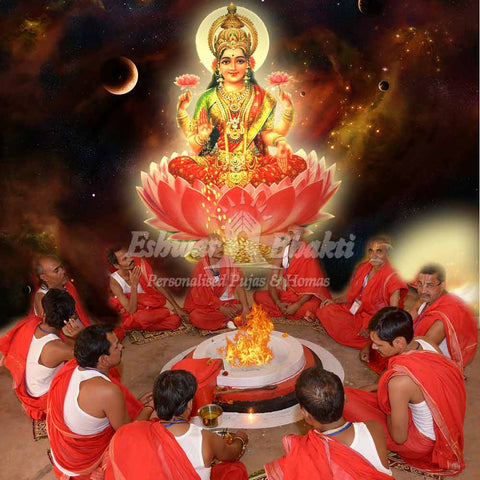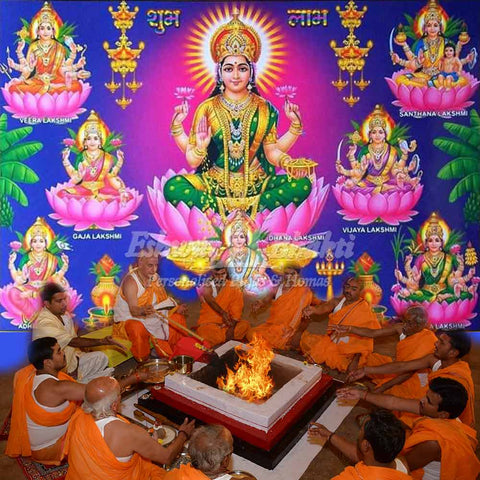Goddess Lakshmi
 Hinduism is one of the few religions that give as much importance to goddesses as it gives to gods. Devi is of paramount importance in Hinduism. Now, Devi is revered in different forms throughout the culture. One of the most important forms in which the Devi is worshipped is in the form of Lakshmi. Lakshmi is a very prominent Devi in Hindu culture.
Hinduism is one of the few religions that give as much importance to goddesses as it gives to gods. Devi is of paramount importance in Hinduism. Now, Devi is revered in different forms throughout the culture. One of the most important forms in which the Devi is worshipped is in the form of Lakshmi. Lakshmi is a very prominent Devi in Hindu culture.
Significance of Goddess Lakshmi: The word Lakshmi finds its origin in the Sanskrit word Lakshya. The word Lakshya means goal, target, or ambition. So, Lakshmi is a reminder for us to be clear and focused on our target. If one observes the Devi, he will find multiple characteristics in her appearance.
She is depicted as having four hands. Those four hands are symbolisation of the four responsibilities of a human being according to Hinduism which are Dharma, Artha, Kama, and Moksha.
She is generally depicted as having a lotus flower in her hand. The Lotus flower is a very respected symbol in Hindu tradition. Lotus is the only flower that blooms in mud, yet retains its beauty. That is the message of Devi as well. To not get dirty with the worldly Maya even while indulging with it, and to retain one's innocence and purity. Lotus is depicted as a symbol of Moksha or ultimate liberation in Hinduism. That's why Lakshmi carrying the flower is so significant.
Vehicles of Lakshmi: She is sometimes depicted as sitting on an owl, while sometimes she is sitting on an elephant. However, owl as her vehicle is much more common in Her portrayal. The owl is a symbol of immense patience and purity. It also signifies how one should find one's way even amidst the dark.
Lakshmi as the goddess of wealth: Most people know Lakshmi as the goddess of wealth. In fact, she is depicted with a jar full of gold coins in Her hand. Sometimes, one may find gold showering out of Her hand. But that is just a symbol. She represents prosperity, abundance, growth, purity, and sanctity in one's life.
These need not be necessarily material. She represents spiritual growth and prosperity as well. Looking up to Her as only a goddess of material wealth is a very shallow approach. She blesses one with a very joyous and prosperous life that leads to the upliftment of the person in terms of growth as a person.
Origin of MahaLakshmi as per Puranic Stories: According to one text, she was found sitting on a lotus at the time of the creation of existence. However, the most popular story remains that she was found during Samundra Manthan.
Samudra Manthan is a very popular Vedic event. In the pursuit of nectar, once both the devas and asuras started churning the ksheersagar. Vishnu took the form of a tortoise and a giant mountain was placed on His back. Then, the giant serpent Vasuki was used as a rope to churn the ocean using the mountain. While devas pulled from one side, asuras pulled from the other.
Before the nectar came out of the ocean, many other things also came out. It is during this churning that Lakshmi appeared from the ocean. Among the devas and the asuras, she chose to remain with devas. And among devas, she chose Vishnu as Her eternal consort. That's why many texts mention Her as the daughter of the ocean. However, some texts also mention her as the daughter of sage Bhrigu.
Lakshmi as Prakriti: We all are familiar with the concept of Purusha and Prakriti in Hinduism. It is one of the central concepts in the Hindu spirituality. Purusha is the eternal consciousness that is the source of all that exists in existence. Purusha is calm and dormant in its own way.
Prakriti is the energy that signifies movement. Prakriti when confluence with Purusha, this existence came into being. All that we see around us is Prakriti, or in common terms, we can call it nature. That which resides in the center of everything is Purusha or consciousness. In the Vaishnavite tradition, Devi or Lakshmi has been symbolised as Prakriti, while Vishnu has been symbolised as Purusha. And this existence is an eternal play of Purusha and Prakriti.
Ashta Lakshmi: When Lakshmi manifests in eight subforms, she is called Ashta Lakshmi. Each Lakshmi represents a specific source of wealth and power. The Ashta Lakshmi are as follows:
 Adi Lakshmi: Adi means first or ancient. She is depicted as the first form or manifestation of Lakshmi.
Adi Lakshmi: Adi means first or ancient. She is depicted as the first form or manifestation of Lakshmi.
Gaja Lakshmi: Lakshmi with elephants on Her either side showering wealth and prosperity. She is Gaja Lakshmi. Gaja means elephant in Sanskrit.
Vijaya Lakshmi: Vijaya means victory. Vijaya Lakshmi symbolises victory. -
Dhanya Lakshmi: Dhanya Lakshmi symbolises blessings of prosperity. However, some interpret her as a giver of granary wealth.
Dhana Lakshmi: Dhana Lakshmi symbolises wealth.
Vidya Lakshmi: Vidya Lakshmi symbolises knowledge. She also symbolises one's wisdom and conscience.
Veera Lakshmi: Veera means one who is courageous. Veera Lakshmi symbolises courage.
Sanatana Lakshmi: Santana Lakshmi symbolises progeny and continuity.
Lakshmi in Hindu texts: Lakshmi is one of the most frequently appearing goddesses in the Hindu texts. The first mention of Lakshmi is found in Rig Veda. She also finds mention in Atharvaveda. However, it is in the Puranas that various stories and characteristics of Lakshmi are explored in depth. Vishnu Puran in particular has dedicated many sections exclusively to her.
Lakshmi is also mentioned in Upanishads. She is regularly mentioned in the Shakta Upanishads. Shakta Upanishads are dedicated mainly to tridevis which consists of Lakshmi, Parvati, and Saraswati. There is an Upanishad exclusively dedicated to her known as SaubhaghyaLakshmi Upanishad. This Upanishad talks about her powers, characteristics, and many other aspects. Although the first part of the Upanishad focuses on material pursuits, gradually, it shifts focus on spiritual growth and transcendence of a person.
Festivals associated with Lakshmi: Lakshmi is the central goddess of the biggest festival in India, Diwali. Although Diwali is celebrated in different parts of India differently, even for different reasons. But the majority of the people celebrate Diwali in the form of Lakshmi Puja. Diwali is the festival of lights, which signifies the victory of good over evil, knowledge over ignorance, and light over darkness.
During Diwali, people clean their houses, decorate it with various lights and stuff to make it appear beautiful. On Diwali night, diyas lit up the whole environment and a beautiful atmosphere is celebrated. Diwali is an invitation to Lakshmi to enter one's house and bless it with purity and Prosperity.
Not only Diwali, but Lakhmi is also worshipped in the form of Gaja Lakshmi on Sharad Purnima. It is a full moon day in the Hindu month of Ashwin. This is called Gaja Lakshmi Puja. This day is also important because it marks the end of monsoon and hence the festival of harvest. Devi is thanked on this day for the harvest of the season.
Summary: She might appear as a goddess of wealth and prosperity. But, if one explores the depth, She is conveying the message to go beyond the material pursuits and start searching for the real wealth that lies within us. Because, in the end, that is the wealth that really matters. Once that wealth has been found, life becomes a song, a dance, a celebration of the divine.




Comments
Well written about Mahalakshmi. I feel Ashtalakshmis role in our life and Goddess Lakshmis influence in our life could be elaborates.🕉🌈👌❤👍💐